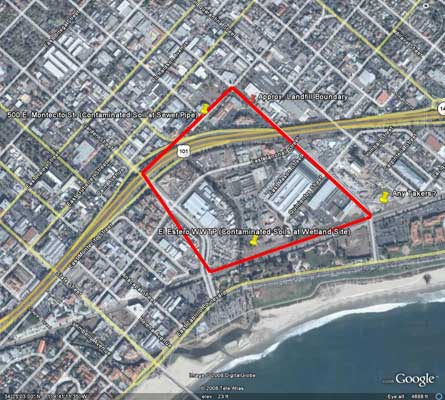City and Activists Spar over Toxic Dirt
Old Funk Zone City Dump May Be Source of Lead and Fecal Contaminants

A mystery has been brewing for decades in the dirt south and east of the Garden Street onramp to the southbound 101. Where an estero once thrived before being filled in by debris from a former city-run dump now stands a largely industrial side of Santa Barbara: the wastewater treatment plant, gas and oil facilities, the labor line, and an expansive hodgepodge of warehouses. After nearly a decade of procedural posturing, speculation, and the occasional bad-news water sample, the California Regional Water Quality Control Board-thanks in large part to the watchdog efforts of area nonprofit Heal the Ocean-told the City of Santa Barbara that it must determine what exactly is underneath Santa Barbara’s ugliest part of town.
Before the neighborhood became what it is today, it was one of Santa Barbara’s busiest landfills. According Stephen MacIntosh, the city’s Public Works Environmental Services director, the 120-acre estero, or estuary, area roughly located mountainside of the railroad tracks and bordered by Santa Barbara, Montecito, Quarantina, and Carpinteria streets was the primary dumping ground for the city-officially called a Class II landfill-from 1920 to 1925, serving as the final resting place for household debris like cans, bottles, tires, paper, and floor sweepings. Other, more toxic and messy garbage and waste, as per a 1920 city law, was hauled out to a hog farm in Goleta. After the earthquake of 1925, the landfill reopened and was used primarily as a place to put debris and rubble as a means of eventually filling in the swampy lagoon land. In 1951, the El Estero Wastewater Treatment Center was built, but it wasn’t until 1955 that the nearby landfill was officially closed down, paving the way for the more modern makeup of the neighborhood to emerge. “Most of the material under there is probably 99 percent bricks, rubble, and glass,” explained MacIntosh recently before adding, “And even if there was anything else that wasn’t inert, it has probably already decomposed.”
The folks from Heal the Ocean aren’t so convinced. Pointing to a series of seemingly unrelated events in the past decade or so, Executive Director Hillary Hauser thinks more nefarious things may lurk beneath the surface of the old estero. Before she had even learned that the area was once a landfill site, Hauser and the Heal the Ocean staffers were investigating toxic runoff discovered seeping out of the cracks in the pavement near the Garden Street onramp. “We tested some stuff about eight years ago that was scraped off the wall down there and it was just off the charts,” Hauser recalled. After reporting their findings to the Water Quality Board, they were led to believe that the toxic discharge was from a wood-chipping business in the area. (The Water Quality Board instructed AgriChip to tarp operations during rainy weather).
As time went on, additional water tests conducted near and downstream from the spot continued to show elevated levels of fecal indicator bacteria, lead, and all sorts of hydrocarbon toxins, among other things. These, along with lead-riddled soil city workers discovered when they attempted to restore turtle pools behind the water treatment plant and, more recently, replace sewage pipes near Montecito Street, created a pattern of red flags that Heal the Ocean could not ignore.
Although MacIntosh said the city doesn’t deny the toxic soil and poor-quality water found in the area, it also claims these problems shouldn’t be blamed on the dump. To hear MacIntosh tell it, the lead by the turtle ponds-which he points out is found only in the topsoil-is explained away by a glass factory that used to operate on the site, while the hydrocarbons and other such petroleum-related nastiness are the likely legacy of oil and gas operations in the area. “[The pollutants found] are not even a likely contribution of a landfill,” he said.
In a ruling issued this week, the Water Quality Board agreed partly with MacIntosh’s position but stopped short of giving the area a clean bill of health. According to staff, the city does not have enough data to call the dump benign. Consequently, the city has until July 31 to implement a plan for testing the entire area and some nearby sites in hopes of better understanding what exactly is in the dirt and potentially leaking into the groundwater and ocean. While he thinks the results won’t tell much more than what the city already knows, MacIntosh promised this: “The bottom line is, we are going to clean up anything we find that might be damaging to the environment.”



